They Don’t Make ‘Em Like They Did – 5 Amazing New LED Bulbs
Posted by Richard Clarke on 29th Jul 2013
Despite being an enduring symbol of innovation, the incandescent light bulb isn't really all that innovative any more. In fact, the design hasn't changed very much at all since Thomas Edison introduced it in 1879.
As well as looking very similar to their 1879 counterparts, today’s incandescent light bulbs still generate light in an extremely wasteful way, by converting as little as 10 per cent of the energy they consume into useful light.
In recent years, the demand for brighter, more efficient lighting has encouraged manufacturers to completely rethink the design of their light bulbs. First, we were treated to the curly-whirly CFL (Compact Fluorescent Lamps), and then came the hi-tech, truly energy-saving LED light bulb.
The following are just 5 of the most unconventional-looking LED light bulbs we have come across.
Philips’ L-Prize-Winner
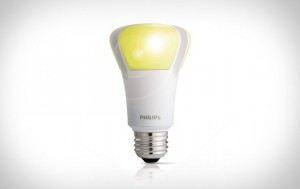 One of the most striking things about Phillip's bulb (pictured above); winner of last year's prestigious US Department of Energy L-Prize competition, is its interesting colour. So, what’s the yellowness all about?
One of the most striking things about Phillip's bulb (pictured above); winner of last year's prestigious US Department of Energy L-Prize competition, is its interesting colour. So, what’s the yellowness all about?
Well, the yellow casing is actually a remote phosphor. If you were to remove the cover, you’d notice that the LEDs underneath are actually a blue-violet colour. The light from the LEDs is absorbed by the cover and reemitted as white light.
Similar to our LED light bulbs, there’s absolutely no flicker or hum with the Philips model, and the colour faithfulness is also reportedly excellent. Its 92 CRI (Colour Rendering Index) is spectacular, making the light it emits very similar to that of naturally occurring daylight.
Colour temperature is different from CRI, but it’s good to know that it produces warm, yellowish light exactly like an incandescent bulb. And this bulb is very bright; at 940 lumens, it's 17% brighter than the 800 lumen output of a 60W incandescent, and all for a 10 watt power requirement.
Liquid Cooled LED Light Bulbs From Switch
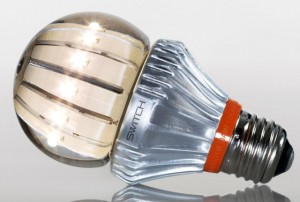
While they generate very little of it to begin with, one of the biggest issues with LED lighting, and one that has played a significant part in their design, is heat.
Put simply, heat shortens the otherwise incredibly long life-expectancy of an LED bulb. Thus, LEDs that are allowed to overheat, tend to fail prematurely.
There are many ways to manage heat. Providing good ventilation for your fitting and ensuring the LED bulbs you buy are fitted with a decent heat sink are just two of them, but lighting designers Switch have opted for a more novel approach: liquid coolant.
In this case, the LEDs are literally immersed in a special fluid that keeps them cool during operation, ensuring they last.
Unfortunately, this doesn't make for a particularly attractive-looking bulb, at least in our opinion, but one thing you can guarantee is that this bulb will last for a very long time!
Bulled By Ledo
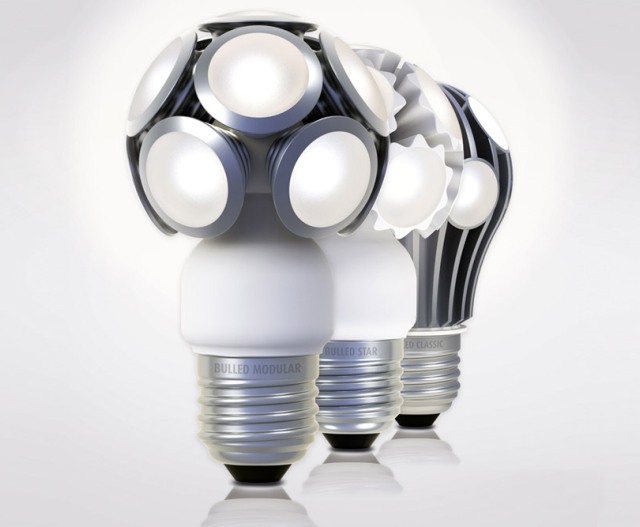 Heat plays an equally important role in Bulled, a series of three, retrofit LED light bulbs from German Company Ledo LED Technologie GmbH, that match the size, shape and brightness of incandescent bulbs whilst being 85% more energy-efficient.
Heat plays an equally important role in Bulled, a series of three, retrofit LED light bulbs from German Company Ledo LED Technologie GmbH, that match the size, shape and brightness of incandescent bulbs whilst being 85% more energy-efficient.
One of the variants is a special production, featuring 20mm Swarovski crystals to create a stunning Aurora Borealis effect that releases playful multi-coloured reflections upon illumination.
All three types of Bulled bulb utilise a combination of cooling fins and fin ducts that regulate the temperature of the 11 dimmable LED modules that are embedded inside.
Due to the design of the bulb, the light from the LEDs is distributed in all directions, in a very similar way to that of a traditional incandescent bulb.
Self Cooling 100 Watt Equivalent LED Bulb From GE
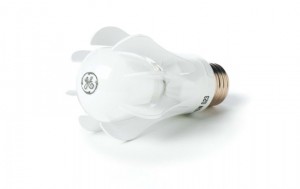
Once again, this LED bulb from General Electric, has been designed with longevity in mind.
The 'fins' enclosing the bulb are in fact a special heat sink, incorporating innovative air stream jet technology, that keeps the LEDs (Light Emitting Diodes) themselves cool, increasing their life-expectancy and energy-efficiency considerably.
NanoLight
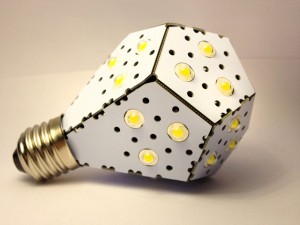 While light bulbs might not be the most exciting products to look at with the technological landscape, they’re nevertheless an absolute necessity and happen to be overdue for a mass upgrade, so it’s great that innovators such as those at the NanoLight Project are beginning to think outside the box in such a big way.
While light bulbs might not be the most exciting products to look at with the technological landscape, they’re nevertheless an absolute necessity and happen to be overdue for a mass upgrade, so it’s great that innovators such as those at the NanoLight Project are beginning to think outside the box in such a big way.
Despite looking rather peculiar, the NanoLight is a very ambitious light bulb design that features complete 360° illumination and produces enough illumination to replace a traditional 100-watt incandescent.
Dubbed “The World’s Most Efficient Bulb” by its designers, the NanoLight promises to generate the same amount of light as a 100-watt traditional incandescent bulb, while consuming just 12 watts of electricity.
By comparison, an average 100-watt replacement compact fluorescent bulb uses about 24 watts of electricity, and a typical 100W-equivalent LED bulb uses around 20 watts.
The makers’ statement that, “This definitely looks like no light bulb that anyone has ever seen before, but maybe that’s what it takes to usher in the future of lighting,” is indicative of the generally forward-thinking attitude within the LED lighting industry today, and is definitely something with which we here at Wholesale LED Lights strongly concur.
The majority of the LED light bulbs mentioned here are very new and quite unusual in their design aesthetics. Whilst those we offer are slightly more modest and conventional looking by comparison, you can be sure that ours all feature the same energy-efficient characteristics and come with a much more reasonable price-tag.
If you know of any more weird and wonderful LED light bulb designs, we’d be delighted to hear about them, so why not leave a comment below?
You can also see our entire range of LED lights by visiting our online store.
If you’d like a chat with one of our customer service advisors about anything LED lighting-related, please don’t hesitate to give us a ring on 0116 321 4120 or send us an e-mail to cs@wled.co.uk.





